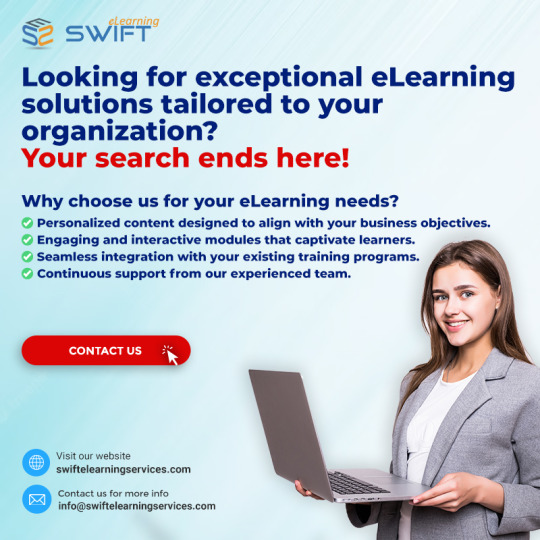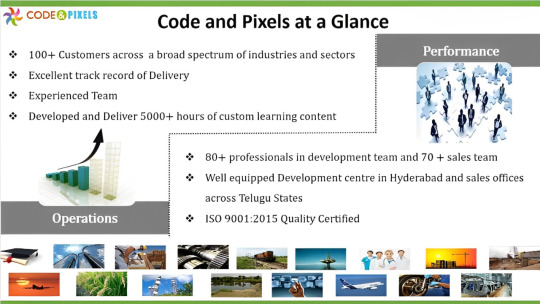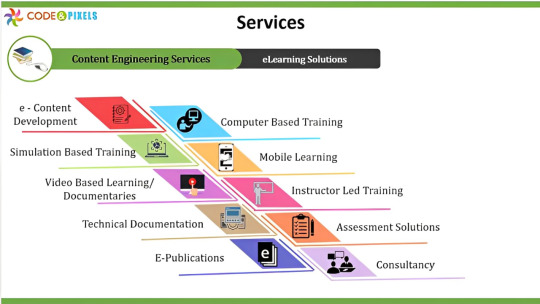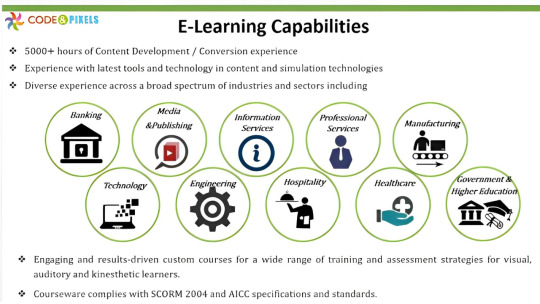#flash to html5 elearning
Explore tagged Tumblr posts
Text

📣 𝗙𝗹𝗮𝘀𝗵 𝘁𝗼 𝗛𝗧𝗠𝗟𝟱 𝗖𝗼𝗻𝘃𝗲𝗿𝘀𝗶𝗼𝗻 | 𝗪𝗲 𝗠𝗶𝗴𝗿𝗮𝘁𝗲 𝗬𝗼𝘂𝗿 𝗖𝗼𝗻𝘁𝗲𝗻𝘁 𝘄𝗶𝘁𝗵 𝗘𝗮𝘀𝗲 ⚡➡️📄
⏩ Adobe Flash's exit marked a game-changer in eLearning and multimedia. ✨ With Flash Player discontinued in 2020, organizations raced to transform Flash courses to HTML5. This shift, vital for compatibility, security, and accessibility, gave rise to lifesaving Flash to HTML5 conversion tools. 🎯 Discover top eLearning authoring tools for seamless conversion in our detailed blog. ✅
🔗 𝙍𝙚𝙖𝙙 𝙩𝙝𝙚 𝙛𝙪𝙡𝙡 𝙖𝙧𝙩𝙞𝙘𝙡𝙚 𝙪𝙨𝙞𝙣𝙜 𝙩𝙝𝙚 𝙗𝙚𝙡𝙤𝙬 𝙡��𝙣𝙠! https://www.swiftelearningservices.com/top-5-tools-for-seamless-flash-to-html5-conversion/
👉 𝙑𝙞𝙨𝙞𝙩 𝙤𝙪𝙧 𝙬𝙚𝙗𝙨𝙞𝙩𝙚 𝙛𝙤𝙧 𝙢𝙤𝙧𝙚 𝙞𝙣𝙨𝙞𝙜𝙝𝙩𝙨: https://www.swiftelearningservices.com/
0 notes
Text
Custom eLearning Solutions for Effective Learning and Development

Custom eLearning solutions design interactive, engaging courses tailored to meet your specific training needs at competitive prices.
Our eLearning Solutions:
Rapid eLearning
Blended Learning
Legacy Content Conversion
Translation & Localization
Learning Management System (LMS)
Human Resource Management System (HRMS)
What is Custom eLearning?
Custom eLearning provides personalized online courses that cater to the unique needs of learners and organizations. Our goal is to enhance training effectiveness and maximize return on investment (ROI).
The transition from ILT/VILT to eLearning: Convert classroom-based training into SCORM and HTML5 content for interactive, accessible learning.
Microlearning Solutions: Bite-sized modules designed for on-the-go learning to improve quick knowledge retention.
Game-Based Learning Solutions: Engage learners through interactive, game-based learning strategies for effective knowledge transfer.
eLearning Content Development
We offer tailored learning experiences designed to meet specific objectives and learner needs.
Rapid eLearning: Quick, efficient course development using rapid authoring tools.
Blended Learning: Seamlessly integrates in-person and online learning for a balanced training approach.
Custom eLearning Samples
Explore our diverse range of custom eLearning solutions that enhance employee skills through interactive modules and simulations.
Content Conversion Solutions
Legacy Content Conversion: Modernize outdated materials into digital formats.
Flash to HTML5: Upgrade Flash-based courses for compatibility with modern standards.
PPT to eLearning: Turn PowerPoint presentations into engaging eLearning content.
ILT to eLearning Conversion: Transform traditional training materials into dynamic eLearning courses.
Translation & Localization Solutions
Our translation services convert eLearning content into various languages, while localization adapts it to fit specific cultural contexts.
eLearning Translation Services: Convert text, images, audio, and video for multilingual learners.
Multimedia Localization: Adapt multimedia elements like graphics, animations, and more for different audiences.
Our Approach
Storyboarding: Visualizing the course structure for better clarity.
Multimedia-Rich Content: Enhance engagement with videos, animations, and infographics.
Personalization: Tailored learning experiences to match individual needs.
Scenario-Based & Gamified Learning: Real-life challenges and gamification drive deeper understanding and motivation.
Compliances and Standards
We ensure compatibility with eLearning standards such as SCORM, xAPI, and HTML5, as well as mobile responsiveness across devices. We also utilize cutting-edge technologies like AI, VR, and AR to enhance learner engagement.
Custom vs. Off-the-Shelf eLearning
Custom eLearning: Tailored to your specific organizational needs, goals, and brand identity.
Off-the-Shelf Courses: Standardized solutions for quick deployment and cost-efficiency.
Elevate Your Training
We specialize in training for:
Onboarding
Safety & Compliance
Sales & Product Knowledge
Leadership & Soft Skills
Industries We Serve
Our eLearning solutions cater to diverse industries, including corporate organizations, educational institutions, healthcare, and government.
eLearning Authoring Tools
We use industry-leading tools like Articulate Storyline, Adobe Captivate, and Camtasia to deliver high-quality, custom eLearning content.
What Our Clients Say
“Swift provided excellent support in developing our online course. Delivered on time and within budget, the course is now widely used and highly effective.”— Mark Cozens, Principal Veterinary Officer
Please send us your requirements at:[email protected]://www.swiftelearningservices.com/contact-us/
FAQs
Why choose custom eLearning?
Custom eLearning offers flexibility, and enhanced engagement, and aligns closely with your goals.
What does it cost?
Costs typically range from $2000 to $8000, depending on the complexity and customization required.
How long does it take?
Custom eLearning content development generally takes 3 to 5 weeks per hour of content.
Can you customize eLearning content to reflect our brand?
Yes, we tailor all content to align with your company’s branding and values for a consistent learning experience.
#custom eLearning solutions#customs eLearning#custom eLearning development#eLearning development#custom eLearning content#bespoke eLearning#custom eLearning services#custom eLearning content development#custom eLearning design#customized eLearning#eLearning solutions
1 note
·
View note
Text

🚀 Make Your eLearning Content Compatible with All Devices! 🌐 Brilliant Teams ensures the compatibility of your eLearning content with our Flash to HTML5 conversion services. Upgrade today to enhance accessibility for all learners!
#Accessibility#eLearning#FlashToHTML5#LearningManagementSystem#eLearningSolutions#SeamlessLearning#InnovativeLMS#EducationTechnology#UserFriendlyLMS#ContentUpgrade#InclusiveLearning
0 notes
Text
E-learning content Development Company in Hyderabad Code and Pixels
E-Content development
At Code and Pixels, we believe that great training begins with great content.
Code and Pixels provides customised and current learning content that makes you stay competitive — right from knowledge transfer of company processes and systems to product information. Such technically heavy and complex content becomes a challenge for the trainer to deliver and difficult for end users to consume in conventional training formats. Hence,

We develop custom E-learning content which is:
Sound using instructional design principles and pedagogy
Compliant with international E-learning standards
A combination of multiple media — games, quizzes, tests, simulations, video, animation, audio and graphics.
Compatible and runs on any standard Learning Management System (LMS)
Highly interactive and enables tracking and scoring of each learner’s progress
Multilingual
We employ a multitude of technologies and tools like graphics, animations, audio-visuals, interactive games and activities that help in giving the right information in the right manner to the right audience.
Mobile Learning/HTML 5
We are living in a multi-device world. We now have options to deliver eLearning using a wide variety of devices such as desktops, laptops, tablets and smart phones. Whether it is for smart phones or tablets — using platforms like Android, BlackBerry or iOS– we develop any kind of solution which suits your mobile learning needs perfectly.

What Is HTML5?
HTML5 is the newest hyper text markup language for websites from the World Wide Web Consortium (W3C). The first draft was made public in 2008, but not much happened until 2011. In 2011, HTML5 was released and people started writing about it and using it, but the support in different browsers was still poor. Today all major browsers (Chrome, Safari, Firefox, Opera, IE) offer HTML5 support, therefore the newest HTML technology can be used at its best today.
Major browsers
IE9+, FF4+, Safari5+, Opera11+, Chrome10+, Blackberry Browser, Silk
Platforms
iOS, Android, ChromeOS, BlackberryOS, Symbian, Windows Mobile 7.5+
Libraries
Webkit (Google, Apple, etc.), Gecko (Mozilla), Trident (Microsoft), Presto (Opera)
A reality indeed. As HTML5’s impact continues to ripple, many companies are dealing with the necessity of abandoning Flash applications. HTML5 is more flexible, allows movement, doesn’t affect SEO and doesn’t need a plug-in.

The migration of Flash eLearning courses to HTML5
eLearning, Training, Media organizations andmarketing departments of all kinds of companies have huge volumes of Interactive Flash content that has traditionally been consumed on desktops. With the rapid proliferation of smart phones and tablets, enterprises are faced with the prospect of their existing content becoming obsolete, since popular mobile platforms don’t support Interactive Flash.
While new content can be developed on a platform an industry standard format like HTML5, ground-up redevelopment of existing Interactive Flash content for mobile devices is not an option for most enterprises. What they need is a high-quality yet rapid solution for migrating their legacy of Interactive Flash content to HTML5.
Flash to HTML5 Migration
We shall take your existing Interactive Flash content and use the Flash to HTML Framework to re-purpose it to make it usable and HTML5 content that is suitable for a variety of devices including desktops, smart phones & tablets.
Powered by HTML5, CSS3 and JavaScript, our Flash to HTML5 framework enables us to accelerate speed-to-market for the new HTML5 content while preserving the richness of the original Flash content.
The new HTML5 content is able to fulfill the greater demands on usability posed by the varying screen sizes and resolutions of mobile devices. Recognizing that mobile devices don’t always have the same processing horsepower of desktops, our migration/conversion process leverages our framework to ensure that the repurposed HTML5 can perform on the most popular mobile platforms.
The framework adheres to content standards and supports various fundamental interactive behaviors like programmed workflows, directional information, enhanced content Menus, Multimedia Content Delivering, 2D Animations, Voice Synchronization, Interactivity, Status Bar, Volume Controllers, Slide Bar, Bookmark, Search, Standard navigation features i.e. Next, Previous, Menu amongst several others
With mobile devices being used and preferred for numerous multimedia applications, we shouldn’t forget something that Apple first pointed out. Flash does use too much processing and battery power; something that makes it disadvantageous. So migration to HTML becomes unavoidable.
In a continuously changing and fast paced environment, we can’t chain users to their desks and offices. So the creation of HTML5 eLearning applications, training material, presentations etc. or the conversion of Flash to HTML for mobile devices has become inevitable.
#E-learning#E-learning software#E-learning standards#Learning Management System#eLearning applications#ietm#ietm code and pixels ietm hyderabad#code and pixels#ietm developement#ietm level iv#elearning#ietm software#ietm level 4#technology#software#paradisosolution#mmgen2
1 note
·
View note
Text
Tiêu chuẩn phần mềm đào tạo trực tuyến Elearning
Với sự phát triển mạnh mẽ của hệ thống đào tạo trực tuyến Elearning, việc lựa chọn một nền tảng chuẩn cho nội dung khóa học là một quyết định vô cùng quan trọng. Hiện nay, hầu hết các phần mềm e-learning đều sử dụng một trong ba chuẩn cơ bản: chuẩn SCORM, chuẩn AICC và chuẩn xAPI (hay còn gọi là chuẩn Tin Can).
Việc lựa chọn app học online không phù hợp với doanh nghiệp sẽ dẫn đến hiệu quả đào tạo giảm đi rất nhiều, phải tốn thêm chi phí để định dạng lại nội dung.
Vậy các công ty nên xem xét việc lựa chọn sử dụng các tiêu chuẩn phần mềm như thế nào? Trong bài viết dưới đây, chúng tôi sẽ giới thiệu tổng quan về 3 chuẩn phổ biến nhất của phần mềm đào tạo trực tuyến Elearning hiện nay.
SCORM - Giải pháp số 1 hiện nay
Nếu đang tìm hiểu về phần mềm dạy học trực tuyến elearning hay thiết kế khóa học Elearning, chắc hẳn bạn đã nghe đến thuật ngữ SCORM (Shareable Content Object Reference Model).
Đây là một bộ tiêu chuẩn thiết kế giảng dạy cơ bản do Hoa Kỳ thiết lập vào năm 2000. Tiêu chuẩn này bao gồm ba yếu tố chính: trình bày bài học, phân phối chương trình và điều phối. Chúng được xây dựng trên JavaScript và XML.
SCORM được coi là tiêu chuẩn hàng đầu cho phần mềm đào tạo trực tuyến. Trên thực tế, có tới 62% công ty sử dụng tiêu chuẩn SCORM cho các khóa đào tạo quản lý nhân sự của họ.
Tại sao SCORM lại phổ biến như vậy?
Có thể thấy, do tiêu chuẩn này đơn giản, dễ hiểu, tương thích hơn với các hệ thống quản lý đào tạo nên hơn hẳn tiêu chuẩn AICC (tiêu chuẩn đầu tiên). Lợi ích bao gồm:
Khả năng tương tác: có thể xuất và nhập vào bất kỳ LMS nào có cùng tiêu chuẩn SCORM, không cần thay đổi định dạng hoặc cấu hình ban đầu
Khả năng thích ứng: SCORM có thể phát triển theo nhu cầu đào tạo của từng công ty. Bạn có thể tự kết hợp và kết hợp các SCO hoặc để người hướng dẫn viết các quy tắc trình tự của riêng họ để khớp với nội dung dựa trên sự tiến bộ của học sinh.
Khả năng truy cập: Nội dung hội nghị có thể được truy cập từ nhiều địa điểm và truyền trực tuyến đến nhiều địa điểm.
Khả năng sử dụng lại: Các khóa học SCORM eLearning có thể được sử dụng lại, sắp xếp lại và áp dụng trong các tình huống và doanh nghiệp khác.
Tuy nhiên, SCORM cũng có nhiều điểm yếu mà khó có đối thủ cạnh tranh như:
SCORM chỉ hỗ trợ hệ thống học trực tuyến LMS
SCORM chỉ được sử dụng khi có hệ thống quản lý đào tạo LMS (không hoạt động trên các trang web tự do hoặc ứng dụng dành cho thiết bị di động)
Nội dung SCORM dựa trên nền tảng Flash khi Internet chuyển dần từ Flash sang html5
0 notes
Text
Tiêu chuẩn phần mềm đào tạo trực tuyến Elearning
Với sự phát triển mạnh mẽ của hệ thống đào tạo trực tuyến Elearning, việc lựa chọn một nền tảng chuẩn cho nội dung khóa học là một quyết định vô cùng quan trọng. Hiện nay, hầu hết các phần mềm e-learning đều sử dụng một trong ba chuẩn cơ bản: chuẩn SCORM, chuẩn AICC và chuẩn xAPI (hay còn gọi là chuẩn Tin Can).
Việc lựa chọn app học online không phù hợp với doanh nghiệp sẽ dẫn đến hiệu quả đào tạo giảm đi rất nhiều, phải tốn thêm chi phí để định dạng lại nội dung.
Vậy các công ty nên xem xét việc lựa chọn sử dụng các tiêu chuẩn phần mềm như thế nào? Trong bài viết dưới đây, chúng tôi sẽ giới thiệu tổng quan về 3 chuẩn phổ biến nhất của phần mềm đào tạo trực tuyến Elearning hiện nay.
SCORM - Giải pháp số 1 hiện nay
Nếu đang tìm hiểu về phần mềm dạy học trực tuyến elearning hay thiết kế khóa học Elearning, chắc hẳn bạn đã nghe đến thuật ngữ SCORM (Shareable Content Object Reference Model).
Đây là một bộ tiêu chuẩn thiết kế giảng dạy cơ bản do Hoa Kỳ thiết lập vào năm 2000. Tiêu chuẩn này bao gồm ba yếu tố chính: trình bày bài học, phân phối chương trình và điều phối. Chúng được xây dựng trên JavaScript và XML.
SCORM được coi là tiêu chuẩn hàng đầu cho phần mềm đào tạo trực tuyến. Trên thực tế, có tới 62% công ty sử dụng tiêu chuẩn SCORM cho các khóa đào tạo quản lý nhân sự của họ.
Tại sao SCORM lại phổ biến như vậy?
Có thể thấy, do tiêu chuẩn này đơn giản, dễ hiểu, tương thích hơn với các hệ thống quản lý đào tạo nên hơn hẳn tiêu chuẩn AICC (tiêu chuẩn đầu tiên). Lợi ích bao gồm:
Khả năng tương tác: có thể xuất và nhập vào bất kỳ LMS nào có cùng tiêu chuẩn SCORM, không cần thay đổi định dạng hoặc cấu hình ban đầu
Khả năng thích ứng: SCORM có thể phát triển theo nhu cầu đào tạo của từng công ty. Bạn có thể tự kết hợp và kết hợp các SCO hoặc để người hướng dẫn viết các quy tắc trình tự của riêng họ để khớp với nội dung dựa trên sự tiến bộ của học sinh.
Khả năng truy cập: Nội dung hội nghị có thể được truy cập từ nhiều địa điểm và truyền trực tuyến đến nhiều địa điểm.
Khả năng sử dụng lại: Các khóa học SCORM eLearning có thể được sử dụng lại, sắp xếp lại và áp dụng trong các tình huống và doanh nghiệp khác.
Tuy nhiên, SCORM cũng có nhiều điểm yếu mà khó có đối thủ cạnh tranh như:
SCORM chỉ hỗ trợ hệ thống học trực tuyến LMS
SCORM chỉ được sử dụng khi có hệ thống quản lý đào tạo LMS (không hoạt động trên các trang web tự do hoặc ứng dụng dành cho thiết bị di động)
Nội dung SCORM dựa trên nền tảng Flash khi Internet chuyển dần từ Flash sang html5
0 notes
Link
This is a great boon that renders technology to go online without sweating or wastage of time. But a pertinent question is, how to streamline conversion efficiencies? And, this is where rapid authoring tools come to play.
Undoubtedly, Array of tools are available in the market, but choosing appropriate and sustainable tools that best meet one’s needs is very challenging. Well, organizations should be very careful in the proper selection of tools that reminisce the functionality of eLearning courses. So, let’s check out what the tools are-
#flash to html5 elearning#flash to html5 conversion tools#conversion of flash to html5#flash to html5 conversion#flash to html5 conversion services#flash to html5 conversion solutions#rapid elearning#rapid elearning services#rapid elearning solutions#rapid elearning development
1 note
·
View note
Link
#HTML5 – The new strategy for improving #mobileLearning
Due to the Incompatibility with #MobileDevices and the increasing popularity of mobile learning and use of #smartphones is forcing many companies to convert their #Flash content into effective HTML5 #eLearning.
Check this blog for more info!
#flash to html5 conversion#flash to html5 conversion services#flash to html5 conversion solutions#flash to html5 elearning#convert flash to html5#convert flash to html5 services#convert flash to html5 solutions#conversion of flash to html5#conversion of flash to html5 services#conversion of flash to html5 solutions
1 note
·
View note
Link
Adobe Flash was undeniably the ever-popular and gold standard of creating eLearning courses that was completely rich in high-level interactivity, engaging animation, visuals, accessibility, variety, uniformity, etc. Unfortunately, incompatibility problems and slow progress have now-a-days made Flash a fewest option.
While learning methodologies took the digital path, inevita flash courses to html5 which became new favorite among eLearning professionals.
Hypertext Markup language 5 (HTML5) is the extremely developed, latest, stable and scalable HTML format that best serves in designing and developing eLearning courses to meet global audience's diverse needs across platforms.
#flash to html5 conversion#flash to html5 conversion services#convert flash to html5#flash to html5#outsource flash to html5 conversion#flash to html5 elearning#flash to html5 elearning services#flash to html5 elearning solutions#flash elearning to html5#convert flash to html5 courses#flash to html5 content#flash to html5 migration#flash to html5 migration services#flash to html5 migration solutions#convert flash to html5 services#convert flash course to html5#converting from flash to html5#convert flash into html5#migrate flash to html5#convert adobe flash to html5#converting flash to html5#convert flash website to html5#how to convert flash to html5#flash courses to html5#flash to html5 conversion solutions
2 notes
·
View notes
Link
In the recent times, the learning needs are changed and the technology has increased at its pace. This has transformed the traditional classroom training into e-learning. The courses that were developed in Adobe Flash or tools whose output is in SWF are now not compatible with the modern devices. Thus there is a need for the flash to html5 elearning conversion to meet the current trends in the eLearning industry.
Let’s see a case study on migrating the legacy content into HTML5.
#flash to html5 elearning conversion#flash to html5#flash to html5 courses#flash to html5 conversion#flash to html5 conversion services#flash to html5 conversion solutions#elearning case study#flash courses to html5 conversion#articulate storyline#legacy course conversion using storyline#rapid courses development#legacy content into html5#authoring tool#html5#authoring tools#case study#elearning#responsive learning#flash to html5 elearning services#flash to html5 elearning#flash to html5 elearning solutions#convert flash to html5#convert flash to html5 services#convert flash to html5 solutions#flash to html5 migration#flash to html5 migration services#flash to html5 migration solutions
1 note
·
View note
Link
Looking for Flash to HTML5 conversion? Swift eLearning services help companies to Convert Flash to HTML5 eLearning courses for effective training programs.
#flash to html5 conversion#flash to html5 conversion services#convert flash to html5#flash to html5#outsource flash to html5 conversion#flash to html5 elearning#flash elearning to html5#convert flash to html5 courses#flash to html5 content#flash to html5 migration
2 notes
·
View notes
Link
Start your Flash to HTML5 conversion, Swift elearning services helps companies to Convert Flash to HTML5 elearning courses for effective training programs.
#flash to html5 conversion#flash to html5 conversion services#convert flash to html5#flash to html5#outsource flash to html5 conversion#flash to html5 elearning#flash elearning to html5#convert flash to html5 courses#flash to html5 content#flash to html5 migration#flash to html5 migration solutions#flash to html5 migration services#flash to html5 conversion solutions#convert flash to html5 solutions#convert flash to html5 services#convert flash to html5 companies#rapid elearning development#elearning#elearning development#elearning development services
1 note
·
View note
Link
Conversion of Flash to HTML5 eLearning courses is to create mobile-friendly interactive learning content for global audiences. However, you can customize or update the course content to meet new learning requirements and improve the visual appeal of the course.
#flash to html5 elearning#conversion of flash to html5#flash to html5 conversion#flash to html5#authoring tools#content authoring tools#elearning courses#elearning#legacy courses#rapid authoring tools#articulate storyline 360#responsive tools#custom elearning#interactive e-learning#elearning content#adobe captivate#lectora inspire#elucidat#corporate learning#flash to html5 conversion services#flash to html5 conversion solutions#flash to html5 services#flash to html5 solutions#flash to html5 companies#convert flash to html5#convert flash to html5#convert flash to html5 services
1 note
·
View note
Link
Adobe Flash was undeniably the ever-popular and gold standard of creating eLearning courses that was completely rich in high-level interactivity, engaging animation, visuals, accessibility, variety, uniformity, etc. Unfortunately, incompatibility problems and slow progress have now-a-days made Flash a fewest option.
While learning methodologies took the digital path, inevitable thanks to the wave of modern standards in the world of eLearning i.e., HTML5 which became new favorite among eLearning professionals.
Hypertext Markup language 5 (HTML5) is the extremely developed, latest, stable and scalable HTML format that best serves in designing and developing eLearning courses to meet global audience's diverse needs across platforms.
#flash to html5 conversion#flash to html5 conversion services#convert flash to html5#flash to html5#outsource flash to html5 conversion#flash to html5 elearning#convert flash to html5 courses#flash to html5 migration#flash to html5 conversion solutions#flash to html5 conversion providers#flash to html5 conversion companies#convert flash to html5 services#convert flash to html5 solutions
1 note
·
View note
Link
With Flash's phased-out and inconvenient legacy, organizations want to facilitate the latest and versatile technique (HTML5) capable of flawlessly meeting compatibility issues and programmer needs.
It is a great boon that renders online technology without sweating or wasting time.
#flash to html5 elearning#conversion of flash to html5#flash to html5 conversion#flash to html5#Authoring tools#content authoring tools#elearning courses#legacy courses#rapid authoring tools
1 note
·
View note